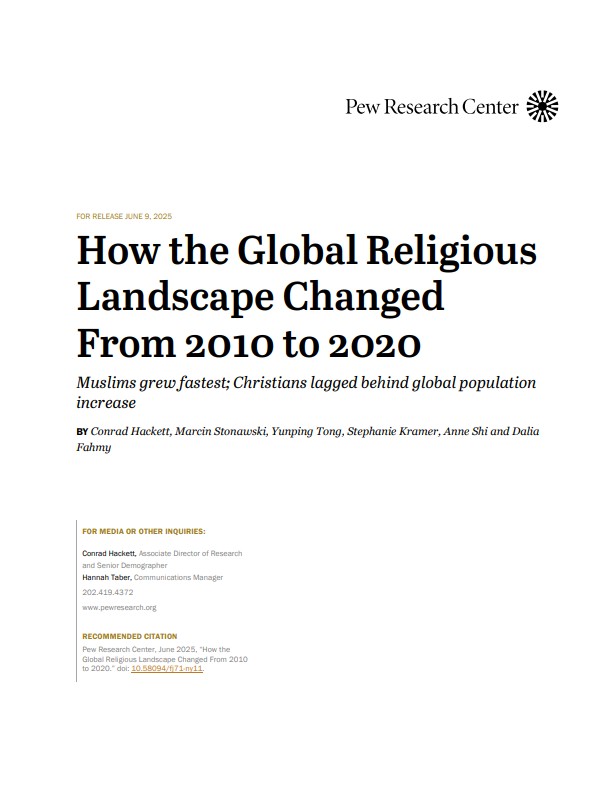
□ 보고서에 따르면, 2020년 현재 전세계 인구 중 75.8%가 종교를 지니고 있다고 답했으며, 어떤 종교에도 속하지 않은 인구는 약 19억 명(24.2%)으로 4명중 1명꼴로 나타남
ㅇ 이같은 '무교' 인구 비중은 2010년(23.3%)보다 1%포인트 증가한 것임. 이는 세계 인구 중 기독교, 이슬람에 이어 세번째로 큰 비중을 차지한 것임. 보고서는 이같은 무교 증가세가 특히 기독교 이탈에 따른 여파로 분석함
ㅇ 조사 기간 기독교인은 10년 사이에 1억2천200만명 증가한 23억명에 달함. 이는 세계 인구 중 최대 비중(28.8%)을 여전히 유지한 것이기는 하지만 10년 전보다는 1.8%포인트 줄어든 것임. 보고서는 기독교 인구 비중이 감소한 것은 종교 이탈에 따른 것으로 파악함
ㅇ 반면 무슬림 인구는 10년 사이에 무려 3억4천700만명 증가한 20억명에 달해 가장 빠른 속도로 성장한 종교로 나타남. 이에 따라 무슬림이 세계 인구 중 차지하는 비중은 1.8%포인트 증가한 25.6%에 달함. 보고서는 이같은 무슬림 증가세가 '놀라운 속도'라고 진단하고, 특히 일부 지역에서 무슬림의 높은 출산율, 비교적 낮은 이탈률 등에 따른 것으로 분석함
□ 보고서 주저자인 콘래드 해킷은 미 일간 워싱턴포스트(WP)에 '전세계에서 기독교인이 되는 젊은층 1명당 기독교를 떠나는 사람은 3명꼴로 나타났다'면서 '이전까지는 고령화, 저출산 여파로 무교 인구도 감소할 것으로 예측했으나 실제로는 기독교 이탈 여파로 무교 인구가 증가했다'고 말함
[출처] '10년간 3억5천만↑' 무슬림, 기독교 맹추격…세계종교지형 급변 (2025.06.10.) / 연합뉴스
목차
About Pew Research Center 1
How we did this 2
Table of contents 4
Regional change 13
Changes within countries 14
Why change occurred at the global level 19
Economic development and religious affiliation 24
Geographic distribution of religious groups in 2020 26
Age profile of religious groups in 2020 27
Do people mostly live as religious majorities or minorities? 29
Revising previous estimates 30
1. Factors driving religious change, 2010-2020 31
Age structure and fertility 33
Religious ‘switching’ 37
Mortality (life expectancy) 41
Migration 43
2. Christian population change 45
Global change 46
Regional change 47
Regional distribution of Christians 48
Countries with the highest Christian counts 49
Where did the Christian share of the population change the most? 50
3. Muslim population change 52
Global change 53
Regional change 54
Regional distribution of Muslims 55
Countries with the highest Muslim counts 56
Where did the Muslim share of the population change the most? 57
4. Religiously unaffiliated population change 59
Global change 60
Regional change 61
Regional distribution of the religiously unaffiliated 62
Countries with the highest religiously unaffiliated counts 63
Where did the unaffiliated share of the population change the most? 64
5. Hindu population change 66
Global change 66
Regional change 67
Regional distribution of Hindus 68
Countries with the highest Hindu counts 69
Where did the Hindu share of the population change the most? 70
6. Buddhist population change 71
Global change 72
Regional change 73
Regional distribution of Buddhists 74
Countries with the highest Buddhist counts 75
Where did the Buddhist share of the population change the most? 76
7. ‘Other religions’ population change 77
Global change 78
Regional change 79
Regional distribution of people of other religions 80
Countries with the highest counts of people of other religions 81
Where did the ‘other religions’ share of the population change the most? 82
8. Jewish population change 83
Global change 85
Regional change 86
Regional distribution of Jews 87
Countries with the highest Jewish counts 88
Where did the Jewish share of the population change the most? 90
9. Religion in Asia and the Pacific 91
Religious change 93
Substantial change within countries 94
Median age of religious groups 95
10. Religion in Europe 96
Religious change 97
Substantial change within countries 98
Median age of religious groups 100
11. Religion in Latin America and the Caribbean 101
Religious change 102
Substantial change within countries 103
Median age of religious groups 104
12. Religion in the Middle East and North Africa 105
Religious change 106
Substantial change within countries 106
Median age of religious groups 108
13. Religion in North America 109
Religious change 110
Substantial change within countries 111
Median age of religious groups 112
14. Religion in sub-Saharan Africa 113
Religious change 114
Substantial change within countries 114
Median age of religious groups 116
15. Why we revised our estimates for 2010 117
How do our 2010 global estimates differ from what we published before? 118
Our new approach to measuring religion in China 120
Our new approach to folk religions 123
Maximizing comparability of sources and methods 124
Other revisions to our 2010 estimates 125
Acknowledgements 127
Methodology 130
Appendix A: Sources 154
Appendix B: Religious composition table 180


